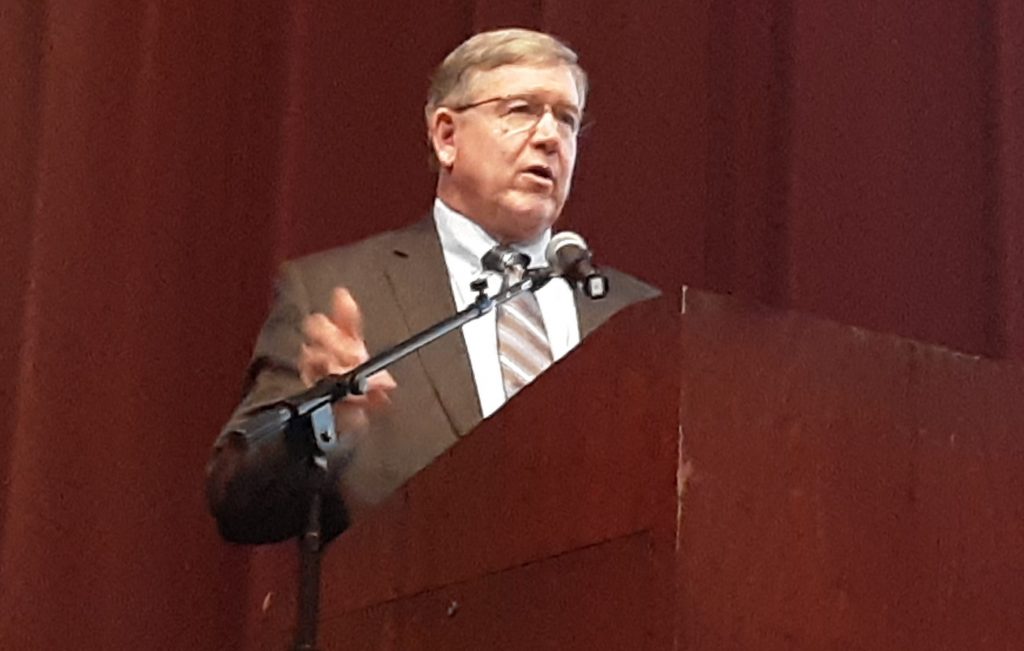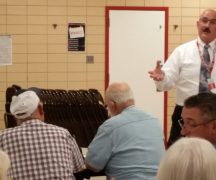By JAN LARSON McLAUGHLIN
BG Independent News
Ohio’s school funding formula has been deemed “unconstitutional” longer than current high school seniors have been alive.
But a bipartisan team of state legislators is working on a bill that is picking up traction throughout the state. On Monday evening, State Rep. Haraz Ghanbari, R-Perrysburg, invited the pair to present their plan for House Bill 305 at Bowling Green City Schools. Ghanbari is a co-sponsor of the bill.
The new formula is intended to be fair to all 612 school districts in Ohio, according to sponsors State Rep. Bob Cupp, R-Lima, and State Rep. John Patterson, D-Jefferson.
The bill focuses on the whole child – and gives districts the money to meet those needs, the legislators said. For example, H.B. 305 will help districts buy school buses, provide art and music, and buy new technology for students.
“We wanted to fund a formula based on student needs,” said Patterson, who was an educator for 30 years before becoming a legislator.
To work, a partnership must be formed.
“The state and the locals must work together,” Patterson said.
To ease the tension between public and private, a change is proposed when students shift from public to private schools.
“We would allow the dollars to follow the students,” Patterson said. “The local districts would be held harmless.”
But Bowling Green Board of Education member Tracy Hovest asked if private schools will be held to the same standards as public schools, since they are getting public funds.
Cupp said that issue goes beyond the funding bill. But Patterson predicted that change will come in the future.
“Where public dollars go, sooner or later, there must be public accountability,” he said.
Cupp said the proposed state funding formula will not be tied to standardized state testing scores.
“The testing and the report cards need an overhaul as well,” he said.

Cupp started the presentation with a brief history lesson on the region’s commitment to education, which started in 1787 with funding for schools and a requirement that one square mile be set aside for education in each township.
But in 1997, the Ohio Supreme Court ruled that the state’s school funding formula was unconstitutional. Twenty-three years later, and it is still broken, still “hopelessly complicated” and still full of provisions for special interests, Cupp said.
State legislators have tried to patch problems with the funding. But that has only resulted in a plan that is more patches than plan, Cupp said.
Ohio is required to provide sufficient funds to supplement local support of schools. Districts that are unable to generate enough tax revenue locally, are supposed to get more state funding.
“The state has an obligation to make sure a district has adequate funds,” Cupp said.
H.B. 305 promises a formula that is rational, predictable, and sustainable for school districts, Cupp said.
Under the existing plan, artificial caps are placed on how much money districts receive. If one district suffers the catastrophic loss of a large factory, the state will provide more funding to that district. But at the same time, the state would cut the funding to all other school districts.
“That is a serious flaw in the funding formula,” Cupp said.
The new formula takes into account the economic challenges of the students, who come to school hungry. Currently, half of Ohio’s children qualify for free or reduced lunches.
“We know we have to do more for those kids,” he said.
The funding will help with preschool programs, giving children the building blocks to help with reading.
“How paralyzed are we as a society if our members cannot read,” Patterson said.
The funding formula focuses on educating the whole child – supporting art, music and gym programs.
“That’s a major step forward,” Patterson said.

“How many programs have you had to cut,” he asked the school officials in the audience.
Under the proposed formula, those programs would not be as much at risk when cuts need to be made. Patterson’s old school has a brand new kitchen for “home-ec,” but no one to teach the class due to funding cuts.
The state would set class size limits, then be required to pay its share for the necessary teachers.
To teach the whole child, funding will also be allotted for guidance counselors, school safety, technology, building leadership, special education, gifted education, and English language learners.
The funding will assist new technology for students, plus help with educational service centers, career tech and STEM programs.
It would also reinstate the state funding for school buses. That funding disappeared in 2009, leaving some districts having to decide whether to spend $80,000 on a new bus or a new teacher.
The funding proposal suggests a blending of property and income taxes for the local share of school revenue. The state would supplement the district’s expenses.
“This would allow each district to be judged in a transparent way,” Patterson said. The funding change would also help stabilize districts and give superintendents the ability to plan more effectively, he said.
As for the state’s share of funding, Patterson noted increases in sales tax revenue, lottery revenue, gambling taxes.
According to Cupp, the proposal meets all the constitutional requirements.
“The constitutional obligation is to make sure districts have enough,” he said. “This would meet the constitutional test.”
Board Green School Board member Norm Geer asked if the state would still view this district as affluent – resulting currently in Bowling Green getting less money per student from the state.
“Are we still going to be considered an affluent district because we are wealthy in land?” Geer asked. Neither bill sponsor could answer that question.
After the meeting, Bowling Green Superintendent Francis Scruci said the formula had several positives.
“This is about the fairest model,” he said. “School funding is so complex.”
As he started the meeting, Ghanbari said the gathering would give him an opportunity to hear from constituents on the issue of school funding.
“The education of our students directly and indirectly affects all Ohioans,” Ghanbari said. “School funding is complex. I wanted to provide an opportunity for dialogue with our constituents as my colleagues and I work through a deliberate and complex legislative process.”





